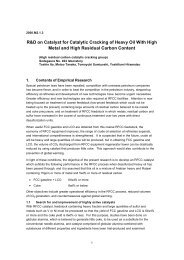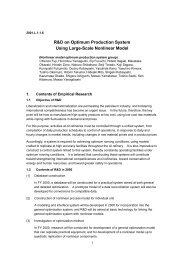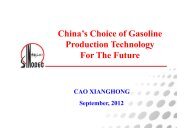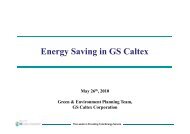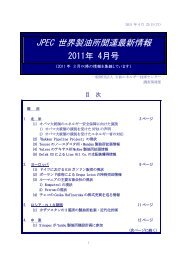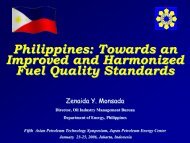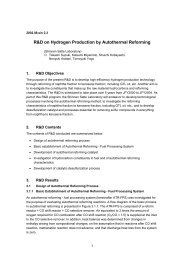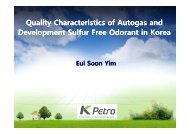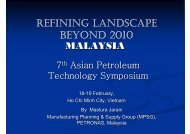Quality Characteristics of BTL Diesel in Korea
Quality Characteristics of BTL Diesel in Korea
Quality Characteristics of BTL Diesel in Korea
Create successful ePaper yourself
Turn your PDF publications into a flip-book with our unique Google optimized e-Paper software.
<strong>Quality</strong> <strong>Characteristics</strong> <strong>of</strong> <strong>BTL</strong> <strong>Diesel</strong><br />
<strong>in</strong> <strong>Korea</strong><br />
Petroleum Technology R&D Cneter<br />
<strong>Quality</strong> Research Team<br />
Don-m<strong>in</strong>, Lee
Contents<br />
01<br />
02<br />
03<br />
Status <strong>of</strong> Bio-fuel<br />
<strong>Quality</strong> <strong>Characteristics</strong> <strong>of</strong> <strong>BTL</strong> <strong>Diesel</strong><br />
Summary
Ⅰ Status <strong>of</strong> Bio-fuel
Fuel & Automobile Technology<br />
Due to energy crisis and global warm<strong>in</strong>g, diversify<strong>in</strong>g energy<br />
sources and develop<strong>in</strong>g highly efficient vehicle are now underway.<br />
Energy crisis require the alternative fuel source and global climate change also urge<br />
to reduce the greenhouse gas.<br />
4/31
Global Bio-fuels Mandates <strong>in</strong> 2011<br />
North America:<br />
RFS2, LCFS, Intermediate blends<br />
Lat<strong>in</strong> America: more<br />
countries push<strong>in</strong>g for<br />
mid and higher<br />
level ethanol blends Ethanol<br />
Biodiesel<br />
Ethanol & Biodiesel<br />
No known bi<strong>of</strong>uels program<br />
5/31<br />
Europe:<br />
RED implementation &<br />
GHG‐sav<strong>in</strong>gs<br />
Asia Pacific:<br />
Blend levels<br />
very high<br />
Source: Hart Energy’s Global Bi<strong>of</strong>uels<br />
Center,<br />
August 2011<br />
Global bi<strong>of</strong>uels policy for mandatory system was focused on low carbon fuel to use <strong>in</strong><br />
transport sector.
Status <strong>of</strong> Bio-fuels for Transport <strong>in</strong> <strong>Korea</strong><br />
Transport Fuel<br />
<strong>Diesel</strong><br />
* R&D on HBD, <strong>BTL</strong><br />
Biodiesel<br />
Gasol<strong>in</strong>e Bioetanol<br />
Natural Gas Biogas<br />
Transport Bioenergy<br />
* R&D on 2 nd generation bio-alcohols(celluosic ethanol, buthanol)<br />
* R&D on bio-gas for road transport fuel<br />
6/31<br />
Dissem<strong>in</strong>ation<br />
* Mandatory<br />
No dissem<strong>in</strong>ation<br />
No dissem<strong>in</strong>ation
Bio-fuel development for <strong>Diesel</strong> <strong>in</strong> transport sector<br />
1 st Generation 2 nd Generation 3 rd Generation<br />
Biodiesel<br />
(FAME)<br />
Process route Trans-esterification<br />
Hydrotreated<br />
Biodiesel (HBD)<br />
Hydro Conversion<br />
<strong>in</strong> ref<strong>in</strong>ery<br />
hydrotreaters<br />
7/31<br />
<strong>BTL</strong><br />
Gasification and FT<br />
synthesis<br />
Biomass<br />
Pyrolysis<br />
Fast pyrolysis<br />
treatment<br />
Feed Vegetable oils Vegetable oils Biomass Biomass<br />
Product BD (FAME)<br />
Product chemical<br />
type<br />
Product quality<br />
Lifecycle analysis<br />
(CO 2 emission)<br />
Fatty acid methyl<br />
ester<br />
Consistency and<br />
stability issues<br />
1.6 – 2.3<br />
(kg CO 2/kg oil<br />
equivalent)<br />
Source : Neste 1)<br />
HBD, Renewable or<br />
Green diesel<br />
Ma<strong>in</strong>ly paraff<strong>in</strong>ic<br />
hydrocarbons <strong>in</strong><br />
diesel boil<strong>in</strong>g range<br />
Syn. <strong>Diesel</strong> Bio-oil, Char, Gas<br />
Ma<strong>in</strong>ly l<strong>in</strong>ear and<br />
branched paraff<strong>in</strong>ic<br />
HCs from upgrad<strong>in</strong>g<br />
waxy FT liquids<br />
High High<br />
0.5 – 1.5<br />
(kg CO 2/kg oil<br />
equivalent)<br />
Source : Neste 1)<br />
-61% to -91%<br />
compared to fossil<br />
diesel<br />
Source : Choren<br />
Complex high mol.<br />
weight HCs, water,<br />
char solids<br />
Low quality energy<br />
carrier<br />
-
Biodiesel Status as an Alterative <strong>Diesel</strong> Fuel <strong>in</strong> <strong>Korea</strong><br />
The Long Term Dissem<strong>in</strong>ation plan for Bio-diesel (’07.9, ’10.12)<br />
Mix Target<br />
Blend ratio <strong>of</strong> bio-diesel for B5 <strong>in</strong>creased by 0.5% each year<br />
from 2007 to 2010.<br />
B20 is limited on the vehicles enabl<strong>in</strong>g to repair <strong>in</strong> their own<br />
facilities to prevent the potential technical problems<br />
Recently, this Plan <strong>in</strong>clud<strong>in</strong>g blend ratio and tax reviewed <strong>in</strong> 2010 and<br />
tax exemption by 2011 and will be keep current blend ratio(2.0%)<br />
Tax Incentives<br />
Feedstock<br />
Infrastructure<br />
<strong>Quality</strong> &<br />
Technology<br />
2007 2008 2009 2010 2011 2012<br />
0.5% 1.0% 1.5% 1.5% 2.0%<br />
2.0% 2.0%<br />
Exemption Tax Exemption Support<br />
Feasibility<br />
Study <strong>of</strong><br />
Multifeedstock<br />
Standard<br />
Re<strong>in</strong>forcement<br />
Demo Plantation <strong>of</strong> Rapeseed<br />
The development <strong>of</strong> low-cost high-efficient biodiesel production technology<br />
8/31<br />
Reviewed<br />
Dissem<strong>in</strong>ation<br />
2.0%<br />
2013<br />
Review<strong>in</strong>g RFS Policy
Ⅱ <strong>Quality</strong> <strong>Characteristics</strong> <strong>of</strong> <strong>BTL</strong> Diese
<strong>Quality</strong> <strong>Characteristics</strong> <strong>of</strong> <strong>BTL</strong> Fuel<br />
Very high cetane (>74)<br />
Aromatic product Free<br />
Sulfur Free<br />
Moderate cetane(~60)<br />
Low aromatic product<br />
10/31<br />
Low cold flow properties<br />
Poor lubricity<br />
(improved by additives)<br />
Good cold flow Properties<br />
(compared with conventional diesel)<br />
<strong>BTL</strong> fuel can be produce F-T process from syngas CO and H 2 derive biomass<br />
Reduced <strong>in</strong> NOx(13%, CO, PM(26%)<br />
(compared to conventional diesel)<br />
Source : SAE-2003-01-0763, NREL
<strong>BTL</strong> Production Process <strong>in</strong> <strong>Korea</strong><br />
Wood<br />
Biomass<br />
Feedstock <strong>of</strong><br />
Gasification<br />
Dry at low temp.<br />
(max. 120 o C )<br />
Hydrothermal-<br />
Pressurization<br />
(250 o C,
<strong>BTL</strong> Fuel Production<br />
<strong>BTL</strong> <strong>Diesel</strong> Production<br />
F-T Process<br />
Syngas(CO+ H 2)<br />
Fe based Catalyst<br />
Gasification<br />
Biomass : Pellet<br />
<strong>BTL</strong> Pilot Plant<br />
<strong>BTL</strong> fuel synthesis<br />
<strong>BTL</strong> Wax<br />
12/31<br />
Distillation<br />
<strong>BTL</strong> <strong>Diesel</strong><br />
(170℃~320℃)<br />
<strong>BTL</strong> Gasol<strong>in</strong>e<br />
(60℃~170℃)<br />
<strong>Quality</strong> <strong>Characteristics</strong> <strong>of</strong> <strong>BTL</strong> diesel for alternative fuel <strong>of</strong> diesel
<strong>Quality</strong> <strong>Characteristics</strong> <strong>of</strong> <strong>BTL</strong> <strong>Diesel</strong><br />
pA<br />
5000<br />
4000<br />
3000<br />
2000<br />
1000<br />
GC analysis <strong>of</strong> <strong>BTL</strong> diesel by distillation<br />
FID1 A, Front Signal (20110125\20110125 2011-01-26 14-10-23\<strong>BTL</strong>50DISTIL.D)<br />
<strong>BTL</strong> after distill.<br />
(Gasol<strong>in</strong>e portion)<br />
0<br />
0 1 2 3 4 5 6 7 8<br />
57℃ ~ 160℃<br />
Iso-parraf<strong>in</strong><br />
pA<br />
2250<br />
2000<br />
1750<br />
1500<br />
1250<br />
1000<br />
750<br />
500<br />
250<br />
FID1 A, Front Signal (20110125\20110125 2011-01-25 16-07-30\<strong>BTL</strong>_1.D)<br />
Gasol<strong>in</strong>e<br />
C12<br />
<strong>Diesel</strong><br />
0<br />
0 1 2 3 4 5 6 7 8<br />
m<strong>in</strong><br />
<strong>BTL</strong> before distill.<br />
(Gasol<strong>in</strong>e+<strong>Diesel</strong>)<br />
13/31<br />
C20<br />
FID1 A, Front Signal (20110125\20110125 2011-01-26 14-28-05\<strong>BTL</strong>50RESIDUE.D)<br />
pA<br />
1200<br />
1000<br />
800<br />
600<br />
400<br />
200<br />
n-parraf<strong>in</strong><br />
m<strong>in</strong><br />
<strong>BTL</strong> diesel after distill.<br />
(<strong>Diesel</strong> portion)<br />
C12<br />
C13<br />
C14<br />
C15 C16<br />
C17<br />
C18<br />
C19 C20<br />
0<br />
0 1 2 3 4 5 6 7 8<br />
m<strong>in</strong>
<strong>Quality</strong> <strong>Characteristics</strong> <strong>of</strong> <strong>BTL</strong> <strong>Diesel</strong><br />
pA<br />
600<br />
500<br />
400<br />
300<br />
200<br />
100<br />
GC analysis <strong>of</strong> <strong>BTL</strong> diesel on pilot Scale<br />
FID1 A, Front Signal (20110125\20110125 2011-01-25 16-07-30\DIESEL.D)<br />
0<br />
0 1 2 3 4 5 6 7 8<br />
pA<br />
1200<br />
1000<br />
800<br />
600<br />
400<br />
200<br />
FID1 A, Front Signal (20110125\20110125 2011-01-26 14-28-05\<strong>BTL</strong>50RESIDUE.D)<br />
0<br />
0 1 2 3 4 5 6 7 8<br />
<strong>Diesel</strong>(w<strong>in</strong>ter)<br />
FID1 A, Front Signal (20110117\20110117 2011-01-17 17-52-19\P_O50_2.D)<br />
pA<br />
900<br />
Keros<strong>in</strong>e<br />
m<strong>in</strong><br />
800<br />
700<br />
600<br />
500<br />
400<br />
300<br />
200<br />
100<br />
14/31<br />
<strong>BTL</strong> diesel<br />
0<br />
0 1 2 3 4 5 6 7 8<br />
m<strong>in</strong><br />
m<strong>in</strong>
<strong>Quality</strong> <strong>Characteristics</strong> <strong>of</strong> <strong>BTL</strong> <strong>Diesel</strong><br />
<strong>Quality</strong> <strong>Characteristics</strong> <strong>of</strong> <strong>BTL</strong> diesel(100%)<br />
Classification Unit Standard <strong>Diesel</strong> <strong>BTL</strong> <strong>Diesel</strong><br />
Pour Po<strong>in</strong>t ℃<br />
0.0 Max.<br />
(w<strong>in</strong>ter : -17.5 max)<br />
15/31<br />
-35.0 -22.5<br />
Cloud Po<strong>in</strong>t ℃ - -4.0 -17.0<br />
Flash Po<strong>in</strong>t ℃ 40 M<strong>in</strong> 44 50<br />
K<strong>in</strong>ematic Viscosity(40℃) mm 2 /s 1.9 ~ 5.5 - -<br />
Distill.<br />
IBP ℃ - 150 171<br />
10% ℃ - 172 190<br />
50% ℃ - 243 232<br />
90% ℃ 360 Max. 334 290<br />
FBP ℃ - 367 312<br />
Carbon Residue <strong>in</strong> 10%<br />
residual oil (wt.%)<br />
Vol.% 0.15 Max. 0.15 Max. 0.15 Max.<br />
Water and Sediment Vol.% 0.02 Max. 0.01 Max. 0.01 Max.<br />
Especially, Distillation temperature <strong>BTL</strong> diesel was low <strong>in</strong> 50% ~ FBP range compared to<br />
conventional diesel.
<strong>Quality</strong> <strong>Characteristics</strong> <strong>of</strong> <strong>BTL</strong> <strong>Diesel</strong><br />
<strong>Quality</strong> <strong>Characteristics</strong> <strong>of</strong> <strong>BTL</strong> diesel(100%)<br />
Classification Unit Standard <strong>Diesel</strong> <strong>BTL</strong> <strong>Diesel</strong><br />
Sulfur Content mg/kg 10 Max. 6.4 1.7<br />
Ash (Weight%) wt.% 0.02 Max. 0.01 Max. 0.01 Max.<br />
Cetane Number -<br />
52 M<strong>in</strong>.<br />
(w<strong>in</strong>ter : 48 m<strong>in</strong>.)<br />
16/31<br />
51.9 68.6<br />
Cetane Number (IQT * ) - - 49.4 54.6<br />
Copper Strip Corrosion - 1 Max. 1 Max. 1 Max.<br />
Lubricity @60℃ (HFRR<br />
WSD)<br />
CFPP ℃ -16 Max. -33.0 -17.0<br />
μm 400 Max. 234 438<br />
Density kg/m 3 815 ~ 835 817 779<br />
Polycyclic Aromatic Content wt.% 5 Max. 1.0 0.2<br />
Aromatic Content Wt.% 30 Max. 18.7 4.1<br />
* Measured by IQT (Ignition <strong>Quality</strong> Tester)<br />
<strong>BTL</strong> diesel was with<strong>in</strong> the limit by national specification except density because it has lower<br />
hydrocarbon numbers compared to conventional diesel.
<strong>Quality</strong> <strong>Characteristics</strong> <strong>of</strong> <strong>BTL</strong> <strong>Diesel</strong><br />
Distillation <strong>Characteristics</strong> <strong>of</strong> <strong>BTL</strong> diesel<br />
Distillation temperature <strong>of</strong> <strong>BTL</strong> diesel was low from 30% to FBP range compared to<br />
conventional diesel.<br />
17/31
<strong>Quality</strong> <strong>Characteristics</strong> <strong>of</strong> <strong>BTL</strong> <strong>Diesel</strong><br />
Low Temp. <strong>Characteristics</strong> <strong>of</strong> <strong>BTL</strong> diesel<br />
Low temperature characteristics <strong>of</strong> <strong>BTL</strong> <strong>Diesel</strong> showed same level<br />
compared to conventional diesel<br />
18/31
Aromatic contents <strong>of</strong> <strong>BTL</strong> <strong>Diesel</strong><br />
Aromatic content analysis <strong>of</strong> <strong>BTL</strong> diesel by HPLC<br />
mono<br />
di tri+<br />
<br />
19/31<br />
mono<br />
* Test method : IP 391, Column : Macherey-Nagel Nucleosil 100-3 NH2(4.6 mm I.D × 25 mm(4.5 µm), Solvent : n-heptane,<br />
flow rate : 0.9 mL/m<strong>in</strong>, Injection amount : 10 µL<br />
Aromatic content <strong>of</strong> <strong>BTL</strong> diesel decreased 4.1wt.% level compared to conventional diesel<br />
di
Lubricities <strong>of</strong> <strong>BTL</strong> <strong>Diesel</strong><br />
PCS Instrument, ISO 12156 Method<br />
2 mL sample, 60 ℃, 75 m<strong>in</strong>, 50 Hz Frequency, 200 g weight<br />
sample sample reservoir<br />
reservoir test test mass<br />
mass<br />
heat<strong>in</strong>g heat<strong>in</strong>g bath<br />
bath<br />
test test ball<br />
ball test test plate<br />
plate<br />
Conventional diesel <strong>BTL</strong> diesel(100%)<br />
20/31<br />
oscillation oscillation motion<br />
motion<br />
Lubricity <strong>of</strong> <strong>BTL</strong> diesel is poor compared to conventional diesel due to low aromatic<br />
content, low sulfur content.
<strong>Quality</strong> <strong>Characteristics</strong> <strong>of</strong> <strong>BTL</strong> blended<br />
GC analysis <strong>of</strong> diesel with <strong>BTL</strong> diesel on pilot Scale<br />
pA<br />
600<br />
500<br />
400<br />
300<br />
200<br />
100<br />
FID1 A, Front Signal (20110125\20110125 2011-01-25 16-07-30\DIESEL.D)<br />
<strong>Diesel</strong><br />
0<br />
0 1 2 3 4 5 6 7 8<br />
pA<br />
700<br />
600<br />
500<br />
400<br />
300<br />
200<br />
100<br />
FID1 A, Front Signal (042F0201.D)<br />
<strong>BTL</strong> diesel<br />
5%<br />
0<br />
0 1 2 3 4 5 6 7 8<br />
FID1 A, Front Signal (043F0301.D)<br />
pA<br />
700<br />
600<br />
500<br />
400<br />
300<br />
200<br />
100<br />
<strong>BTL</strong> diesel<br />
10%<br />
0<br />
0 1 2 3 4 5 6 7 8<br />
m<strong>in</strong><br />
m<strong>in</strong><br />
m<strong>in</strong><br />
21/31<br />
FID1 A, Front Signal (044F0401.D)<br />
pA<br />
700<br />
600<br />
500<br />
400<br />
300<br />
200<br />
100<br />
<strong>BTL</strong> diesel<br />
30%<br />
0<br />
0 1 2 3 4 5 6 7 8<br />
FID1 A, Front Signal (046F0601.D)<br />
pA<br />
700<br />
600<br />
500<br />
400<br />
300<br />
200<br />
100<br />
<strong>BTL</strong> diesel<br />
40%<br />
0<br />
0 1 2 3 4 5 6 7 8<br />
FID1 A, Front Signal (047F0701.D)<br />
pA<br />
700<br />
600<br />
500<br />
400<br />
300<br />
200<br />
100<br />
<strong>BTL</strong> diesel<br />
50%<br />
0<br />
0 1 2 3 4 5 6 7 8<br />
m<strong>in</strong><br />
m<strong>in</strong><br />
m<strong>in</strong>
<strong>Quality</strong> <strong>Characteristics</strong> <strong>of</strong> <strong>BTL</strong> blended<br />
<strong>Quality</strong> characteristics <strong>of</strong> diesel with <strong>BTL</strong> diesel<br />
Classification Unit Standard<br />
Pour Po<strong>in</strong>t ℃<br />
0.0 max.<br />
(w<strong>in</strong>ter : -<br />
17.5 max.)<br />
<strong>Diesel</strong><br />
(w<strong>in</strong>ter)<br />
22/31<br />
Blend ratio <strong>of</strong> <strong>BTL</strong> diesel<br />
5 % 10% 20% 30% 40% 50%<br />
-35 -32.5 -30.0 -27.5 -25.0 -22.5 -22.5<br />
Cloud Po<strong>in</strong>t ℃ - -4.0 -10.0 -10.0 -11.0 -13.0 -14.0 -17.0<br />
Flash Po<strong>in</strong>t ℃ 40 m<strong>in</strong>. 44 44 44 44 44 44 48<br />
K<strong>in</strong>ematic<br />
Viscosity<br />
Distill.<br />
Carbon Residue <strong>in</strong><br />
10% residual oil<br />
Water and<br />
Sediment<br />
mm 2 /s<br />
(40 ℃)<br />
1.9 ~ 5.5 - - - - - - -<br />
IBP ℃ - 150 151 151 153 156 157 160<br />
10% ℃ - 172 172 174 176 178 178 181<br />
50% ℃ - 243 243 243 240 239 237 236<br />
90% ℃ 360 max. 334 332 333 329 325 318 312<br />
FBP ℃ - 367 368 365 365 360 359 355<br />
Wt.% 0.15 max. 0.15 max. 0.15 max. 0.15 max. 0.15 max. 0.15 max. 0.15 max. 0.15 max.<br />
Vol.% 0.02 max. 0.01 max. 0.01 max. 0.01 max. 0.01 max. 0.01 max. 0.01 max. 0.01 max.<br />
<strong>Diesel</strong> on blend ratio <strong>of</strong> <strong>BTL</strong> diesel(5%~50%) was with<strong>in</strong> the limit by national specification<br />
except density but pilot plant system for <strong>BTL</strong> diesel production will be optimized to use <strong>in</strong> <strong>Korea</strong>.
<strong>Quality</strong> <strong>Characteristics</strong> <strong>of</strong> <strong>BTL</strong> blended<br />
<strong>Quality</strong> characteristics <strong>of</strong> diesel with <strong>BTL</strong> diesel<br />
Item Unit Standard<br />
<strong>Diesel</strong><br />
(w<strong>in</strong>ter)<br />
23/31<br />
Blend ratio <strong>of</strong> <strong>BTL</strong> diesel<br />
5 % 10% 20% 30% 40%<br />
Sulfur Content mg/kg 10 Max. 6.40 5.96 5.69 5.28 4.77 4.21 3.88<br />
Ash (Weight%) wt.%<br />
Cetane Number -<br />
0.02<br />
Max.<br />
52 M<strong>in</strong>.<br />
(w<strong>in</strong>ter :<br />
48 m<strong>in</strong>.)<br />
0.01 max. 0.01 max. 0.01 max. 0.01 max. 0.01 max. 0.01 max. 0.01 max.<br />
51.9 52.3 53.3 54.2 55.8 57.2 58.8<br />
IQT * - - 49.4 49.9 50.4 51.5 52.8 53.7 54.6<br />
Copper Strip<br />
Corrosion<br />
Lubricity @60℃<br />
(HFRR WSD)<br />
- 1 Max. 1 max. 1 max. 1 max. 1 max. 1 max. 1 max. 1 max.<br />
μm<br />
400<br />
Max.<br />
234 251 273 314 328 344 378<br />
CFPP ℃ -16 -33.0 -32.0 -31.0 -29.0 -28.0 -27.0 -20.0<br />
Density kg/m 3 815 ~<br />
835<br />
Polycyclic<br />
Aromatic Content<br />
817 816 814 810 806 802 798<br />
wt.% 5 Max. 1.0 0.7 0.6 0.7 0.6 0.6 0.5<br />
Aromatic Content Wt.% 30 Max. 18.7 17.7 16.7 15.7 14.3 13.0 11.5<br />
<strong>Diesel</strong> on blend ratio <strong>of</strong> <strong>BTL</strong> diesel(5%~50%) was with<strong>in</strong> the limit by <strong>Korea</strong>n specification<br />
except density but pilot plant system for <strong>BTL</strong> diesel production will be optimized to use <strong>in</strong> <strong>Korea</strong>.
<strong>Quality</strong> <strong>Characteristics</strong> <strong>of</strong> <strong>BTL</strong> blended<br />
Cetane number by IQT<br />
* Measured by IQT (Ignition <strong>Quality</strong> Tester)<br />
24/31<br />
ASTM D6890<br />
EN 15195<br />
IP 497<br />
Need small sample(20 mL)<br />
High repeatability, reproducibility<br />
Especially, cetane number <strong>of</strong> diesel on blend<strong>in</strong>g ratio <strong>of</strong> <strong>BTL</strong> diesel by IQT <strong>in</strong>creased<br />
on blend ratio <strong>of</strong> <strong>BTL</strong> diesel compared to conventional diesel
<strong>Quality</strong> <strong>Characteristics</strong> <strong>of</strong> <strong>Diesel</strong> with <strong>BTL</strong> <strong>Diesel</strong><br />
Low Temp. <strong>Characteristics</strong> <strong>of</strong> <strong>BTL</strong> diesel<br />
Low temp. characteristics <strong>of</strong> diesel on blend<strong>in</strong>g ratio <strong>of</strong> <strong>BTL</strong> diesel showed with<strong>in</strong><br />
limit by <strong>Korea</strong>n specification<br />
25/31
<strong>Quality</strong> <strong>Characteristics</strong> <strong>of</strong> <strong>BTL</strong> blended<br />
Comparison <strong>of</strong> density v.s aromatic content on blend<strong>in</strong>g ratio<br />
Density(kg/m 3 )<br />
830 Density<br />
Aromatic content<br />
820<br />
810<br />
800<br />
790<br />
780<br />
0 10 20 30 40 50<br />
Blend ratio <strong>of</strong> <strong>BTL</strong> diesel<br />
Density <strong>of</strong> diesel on blend<strong>in</strong>g ratio <strong>of</strong> <strong>BTL</strong> <strong>Diesel</strong> decreased due to reduction <strong>of</strong><br />
aromatic content<br />
26/31<br />
20<br />
18<br />
16<br />
14<br />
12<br />
10<br />
Aromatic content(wt.%)
<strong>Quality</strong> <strong>Characteristics</strong> <strong>of</strong> <strong>BTL</strong> blended<br />
Lubricity on blend<strong>in</strong>g ratio<br />
Base<br />
<strong>Diesel</strong><br />
<strong>BTL</strong> diesel<br />
5%<br />
<strong>BTL</strong> diesel<br />
10%<br />
<strong>BTL</strong> diesel<br />
20%<br />
27/31<br />
<strong>BTL</strong> diesel<br />
30%<br />
<strong>BTL</strong> diesel<br />
40%<br />
<strong>BTL</strong> diesel<br />
50%<br />
HFRR<br />
(μm) 234 251 273 314 328 344 378<br />
Base diesel <strong>BTL</strong> diesel 5% <strong>BTL</strong> diesel 10% <strong>BTL</strong> diesel 20%<br />
<strong>BTL</strong> diesel 30% <strong>BTL</strong> diesel 40% <strong>BTL</strong> diesel 50%<br />
Lubricity <strong>of</strong> diesel on blend<strong>in</strong>g ratio <strong>of</strong> <strong>BTL</strong> diesel was with<strong>in</strong> limit by <strong>Korea</strong>n specification.<br />
but it has poor lubricity compared to conventional diesel.
<strong>Quality</strong> <strong>Characteristics</strong> <strong>of</strong> <strong>BTL</strong> blended<br />
Comparison <strong>of</strong> lubricity v.s sulfur content on blend<strong>in</strong>g ratio<br />
HFRR <strong>of</strong> diesel on blend<strong>in</strong>g ratio <strong>of</strong> <strong>BTL</strong> diesel decreased due to reduction <strong>of</strong> sulfur content.<br />
28/31
<strong>Quality</strong> <strong>Characteristics</strong> <strong>of</strong> <strong>BTL</strong> blended<br />
Comparison <strong>of</strong> lubricity v.s density on blend<strong>in</strong>g ratio<br />
HFRR(µm)<br />
400<br />
380<br />
360<br />
340<br />
320<br />
300<br />
280<br />
260<br />
240<br />
220<br />
HFRR<br />
Density<br />
0 10 20 30 40 50<br />
Blend ratio <strong>of</strong> <strong>BTL</strong> diesel<br />
HFRR <strong>of</strong> diesel on blend ratio <strong>of</strong> <strong>BTL</strong> diesel decreased due to reduction <strong>of</strong> density.<br />
it has a low hydrocarbon content compared to conventional diesel.<br />
29/31<br />
820<br />
815<br />
810<br />
805<br />
800<br />
795<br />
790<br />
Density(kg/m 2 )
<strong>Quality</strong> <strong>Characteristics</strong> <strong>of</strong> <strong>BTL</strong> blended<br />
Comparison <strong>of</strong> lubricity v.s density on blend<strong>in</strong>g ratio<br />
HFRR(µm)<br />
400<br />
380<br />
360<br />
340<br />
320<br />
300<br />
280<br />
260<br />
240<br />
220<br />
HFRR<br />
Density<br />
0 10 20 30 40 50<br />
Blend ratio <strong>of</strong> <strong>BTL</strong> diesel<br />
HFRR <strong>of</strong> diesel on blend ratio <strong>of</strong> <strong>BTL</strong> diesel decreased due to reduction <strong>of</strong> density.<br />
it has a low hydrocarbon content compared to conventional diesel.<br />
30/31<br />
820<br />
815<br />
810<br />
805<br />
800<br />
795<br />
790<br />
Density(kg/m 2 )
Ⅲ Summary
Summary<br />
� Biomass-To-Liquied(<strong>BTL</strong>) can be used <strong>in</strong> conventional diesel eng<strong>in</strong>es, pure orblendedwith<br />
conventional diesel due to its similar physical properties.<br />
� <strong>BTL</strong> was produced by F-T process with syngas(H 2/CO=1), catalyst(FeCU/Al 2O 3)atlowtemperature<br />
condition(240 ℃).<br />
� <strong>BTL</strong> with diesel compositions after distillation is consisted <strong>of</strong> C12 ~ C23+ mixture <strong>of</strong> n-paraff<strong>in</strong><br />
and iso-paraff<strong>in</strong> compounds. Especially, it showed higher content n-paraff<strong>in</strong> products compared<br />
with iso-paraff<strong>in</strong> products.<br />
� <strong>BTL</strong> with diesel compositions showed a very high cetane number, low aromatic contentand<br />
sulfur free level.<br />
� F<strong>in</strong>ally, diesel on blend ratio <strong>of</strong> <strong>BTL</strong> diesel(5%~50%) was with<strong>in</strong> the limit by <strong>Korea</strong>n specification<br />
except density but pilot plant system for <strong>BTL</strong> diesel production will be optimized to use <strong>in</strong> <strong>Korea</strong>.<br />
32/31
감사합니다.




